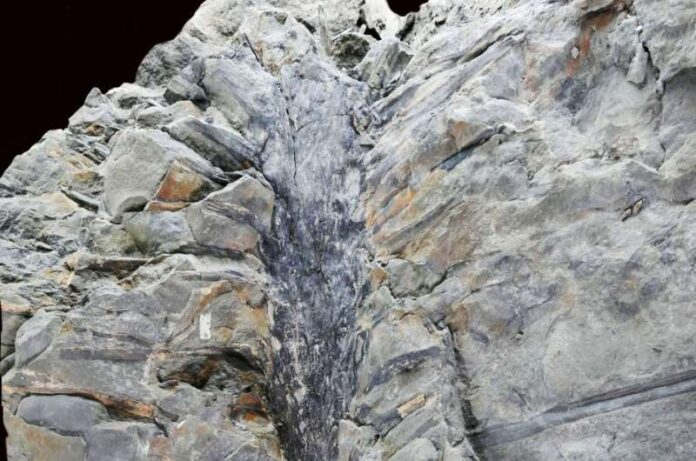“We all have a mental concept of what a tree looks like, depending on where we live on the planet, and we have a vision of what is familiar,” Gastaldo says. “The fossil on which we report is unique and a strange growth form in the history of life. It is one of evolution’s experiments during a time when forest plants underwent biodiversification, and it is a form that seems to be short lived.”
The fossils in question were preserved by earthquake-induced, catastrophic burial of trees and other vegetation along the margin of a rift lake. The first fossil tree was unearthed about seven years ago from a quarry, but it only included one partial sample. It took several years for another four specimens of the same plant, in close spatial proximity, to also be found, Gastaldo says.
One of the specimens revealed how the leaves departed from the top of the tree, which makes it “absolutely unique.” It’s one of only a few in a fossil record spanning more than 400 million years in which a trunk is preserved around which the crown leaves are still attached, the researchers say.
“Any fossil tree with an intact crown is a rarity in the history of life,” Gastaldo says. “Having the crown leaves attached to a trunk, by itself, begs the questions what kind of plant is it, how is that plant organized, And is it some form that continues to the present, or is it outside of the ‘normal’ concept of a tree? All of these questions, and more, led to this multi-year endeavor.”
The researchers report that the tree likely relied on its unusual growth form to maximize the amount of light it could capture and reduce its competition with other plants on the ground. They suggest that the tree now represents the earliest evidence of smaller trees growing beneath a taller forest canopy.
It means that plant life in the Early Carboniferous period was more complex than expected, suggesting Sanfordiacaulis lived at a time when plants were “experimenting” with a variety of possible forms or architectures.
“The history of life on land consists of plants and animals that are unlike any of those that live at the present,” Gastaldo says.
“Evolutionary mechanisms operating in the deep past resulted in organisms that successfully lived over long periods of time, but their shapes, forms, growth architectures, and life histories undertook different trajectories and strategies. Rare and unusual fossils, such as the New Brunswick tree, is but one example of what colonized our planet but was an unsuccessful experiment.”
More information: Enigmatic fossil plants with three-dimensional, arborescent-growth architecture from the earliest Carboniferous of New Brunswick, Canada, Current Biology (2024). DOI: 10.1016/j.cub.2024.01.011. www.cell.com/current-biology/f … 0960-9822(24)00011-3
Journal information: Current Biology
Provided by Cell Press

